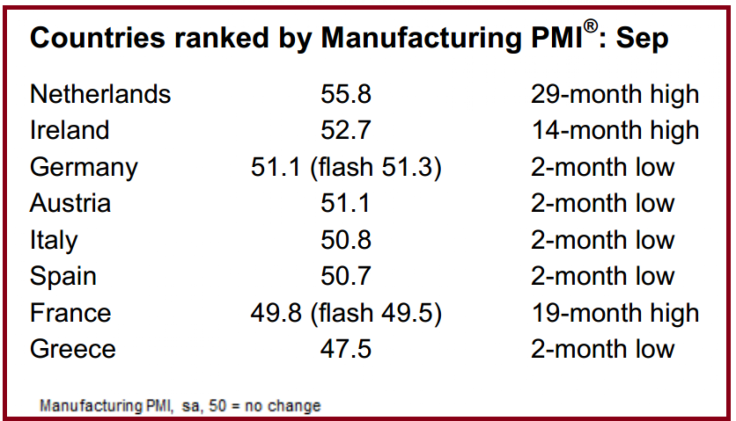Euro Zone Manufacturing PMI In Line With Flash Estimates; Unemployment Remains Unchanged

A benchmark survey of factory output for the euro zone showed that manufacturing activity in the 17-nation bloc expanded for the third-straight month in September, but the rate of growth dipped slightly from the previous month, while unemployment in the region remained unchanged in August.
The euro zone’s manufacturing PMI, published by Markit, expanded to 51.1, in line with the earlier flash reading released a week ago, but slightly lower than the 51.4 reading -- a 26-month high -- recorded in August. The data showed that the region’s economies showed signs of sustained growth with output increasing in all nations with the exception of France and Greece.
“An improvement in euro zone manufacturing business conditions for a third straight month in September sends a reassuring signal that the sector is providing an all-important lift for a region that has been besieged by recession,” Chris Williamson, chief economist at Markit, said in a release.
Production and new orders both increased for the third consecutive month in September, aided by strong improvement in domestic market conditions and foreign demand. However, “rates of expansion in output, new orders and new export orders were all slightly slower than August’s 27-month peaks,” the statement said.
“Even manufacturers in the region’s ‘periphery’ are reporting better demand for their goods. Orders rose for the fourth month running in Spain and for the third successive month in Italy and Ireland. In the region’s ‘core’, orders likewise rose for a third month running in Germany and the Netherlands and even the recent laggard France saw the first upturn in demand for just over two years,” Williamson said.

Meanwhile, the labor market remained the weak in the euro zone as job losses were registered for the twentieth successive month but the rate of decline was only marginal, the survey said.
A separate set of data released by Eurostat, showed that unemployment in the 17-nation euro zone and 28-member European Union remained unchanged at 12 percent and 10.9 percent respectively in August. Germany’s unemployment rate remained unchanged at 5.2 percent in August, from 6.8 percent in the previous month, the Eurostat statement said.
Compared with a year ago, unemployment rose in 16 nations, dropped in 11 and remained stable in Poland. The highest increases were recorded in Cyprus (from 12.3 percent to 16.9 percent) and Greece (from 24.6 percent to 27.9 percent between June 2012 and June 2013). The largest decreases were observed in Latvia (from 15.6 percent to 11.4 percent between the second quarters of 2012 and 2013) and Estonia (from 10.1 percent to 7.9 percent between July 2012 and July 2013), the statement said.
Italy’s unemployment rate rose to 12.2 percent from a revised 12.1 percent recorded in the previous month while the country's youth unemployment figure hit a new record of 40.1 percent in August, up from 39.7 percent, a month ago.
The lowest rates in youth unemployment in August were observed in Germany (7.7 percent) and Austria (8.6 percent), and the highest in Greece (61.5 percent in June 2013), Spain (56.0 percent) and Croatia (52.0 percent in the second quarter of 2013).
© Copyright IBTimes 2024. All rights reserved.












